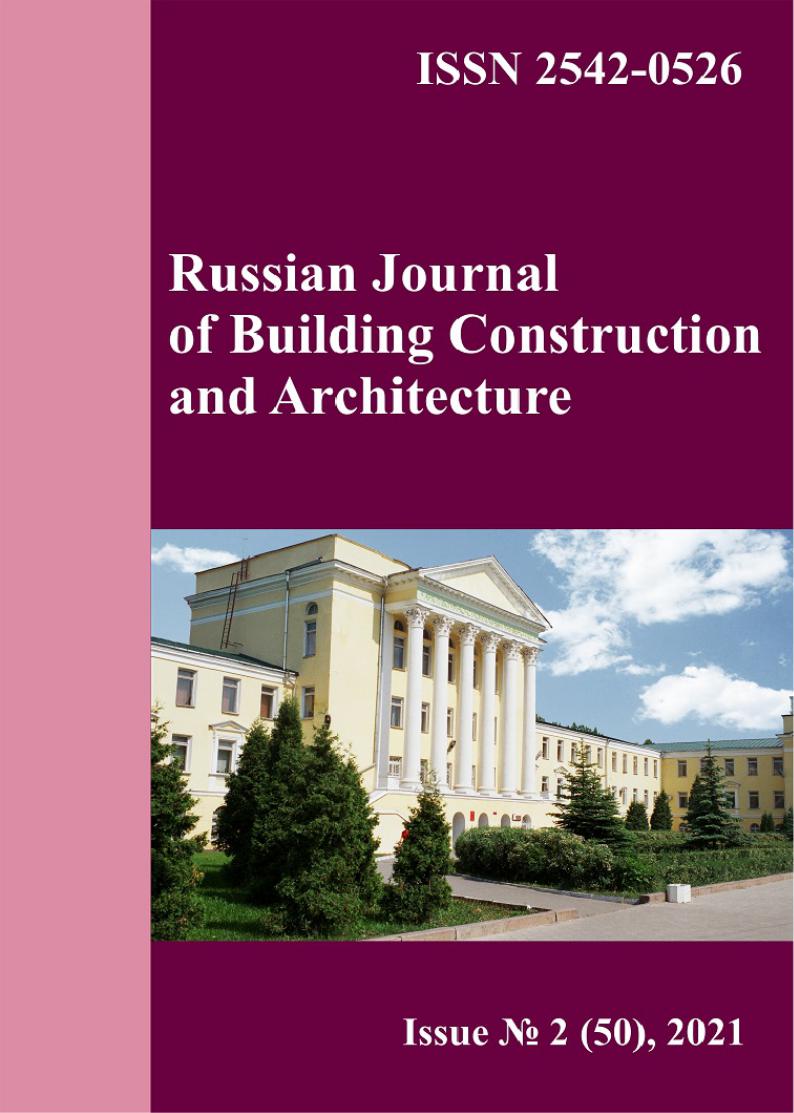
3273
.pdf
RUSSIAN JOURNAL
OF BUILDING
CONSTRUCTION AND ARCHITECTURE

The journal is indexed/abstracted in:
Web of Science Core Collection
(Emerging Sources Citation Index)
(Thomson Reuters), USA
Ulrich's Periodicals Directory
(Bowker), USA
DOAJ
(Lund University), Sweden
Academic Search Complete
(EBSCO), USA
SOCOLAR
(China Educational Publications Import and Export Corporation –– CEPIEC), China
Google Scholar
(Google), USA
E-Library
(ООО «РУНЭБ»), Russia
J-Gate
(Informatics Ltd), India
ISSN 2542-0526
RUSSIAN JOURNAL
OF BUILDING CONSTRUCTION
AND ARCHITECTURE
N 2 (50)
BUILDING STRUCTURES, BUILDINGS AND CONSTRUCTIONS
BASES AND FOUNDATIONS, UNDERGROUND STRUCTURES
HEAT AND GAS SUPPLY, VENTILATION, AIR CONDITIONING, GAS SUPPLY AND ILLUMINATION
BUILDING MATERIALS AND PRODUCTS
TECHNOLOGY AND ORGANIZATION OF CONSTRUCTION
DESIGNING AND CONSTRUCTION OF ROADS, SUBWAYS, AIRFIELDS, BRIDGES AND TRANSPORT TUNNELS
BUILDING MECHANICS
THEORY AND HISTORY OF ARCHITECTURE, RESTORATION AND RECONSTRUCTION OF HISTORICAL
AND ARCHITECTURAL HERITAGE
ARCHITECTURE OF BUILDINGS AND STRUCTURES. CREATIVE CONCEPTIONS OF ARCHITECTURAL ACTIVITY
CITY PLANNING, PLANNING OF VILLAGE SETTLEMENTS
Voronezh 2021

Russian Journal
of Building Construction and Architecture
Periodical scientific edition
Published since 2009 |
Comes out 4 times per annum |
|
|
|
|
Founder and publisher: Voronezh State Technical University.
The territory of distribution — Russian Federation.
The articles are reviewed and processed with the program ANTIPLAGIARISM. This publication cannot be reprinted without the prior permission of the publisher, references are obligatory.
Previous name: «Scientific Herald of the Voronezh State University of Architecture and Civil Engineering. Construction and Architecture».
EDITORIAL BOARD
Editor-in-Chief: Melkumov V. N., D. Sc. in Engineering, Prof.,
Voronezh State Technical University
Boldyrev А.М., Corresponding Member of the Russian Academy of Architecture and Engineering Science, D.Sc. in Engineering, Prof., Voronezh State Technical University, Russia
Bondarev B. А., D. Sc. in Engineering, Prof., Lipetsk State Technical University, Russia
Gagarin V. G., Corresponding Member of RAABS, Moscow State University of Civil Engineering, Russia
Gelfond А. L., Corresponding Member of the Russian Academy of Architecture and Construction Science, D. Sc. in Architecture, Nizhniy Novgorod State University of Architecture and Construction, Russia
Enin A. Ye., PhD in Architecture, Prof., Voronezh State Technical University, Russia
Karpenko N. I., Academician of RAABS, Research Institute of Building Physics (NIISF RAABS), Russia
Kirsanov М.N., D.Sc. in Physics and Mathematics, Professor (National Research University “Moscow Power Engineering Institute”)
Kolchunov V. I., Academician of RAABS, Southwest State University, Kursk, Russia
Ledenyev V. I., D. Sc. in Engineering, Prof., Tambov State Technical University, Russia
Lyahovich L. S., Academician of RAABS, Tomsk State University of Architecture and Building, Russia
Mailyan L. R., D. Sc. in Engineering, Prof., Don State Technical University, Rostov, Russia
Osipova N.N., D. Sc. in Engineering, Yury Gagarin Saratov State Technical University, Russia
Panibratov Yu. P., Academician of RAABS, Saint Petersburg State University of Architecture and Civil Engineering, Russia
Podolsky Vl.P., D. Sc. in Engineering, Prof., Voronezh State Technical University, Russia (Dep. of the Editor-in-Chief)
Suleymanov А.М., D. Sc. in Engineering, Prof., Kazan State University of Architecture and Engineering, Russia
Fyedorov V. S., Academician of RAABS, Moscow State University of Railway Engineering, Russia
Fedosov S. V., Academician of RAABS, Moscow State University of Civil Engineering, Russia
Chernyshov Ye. M., Academician of RAABS, Voronezh State Technical University, Russia
Shubenkov М. V., Academician of the Russian Academy of Architecture and Construction Science, D. Sc. in Architecture, Prof., Моscow Institute of Architecture (State Academy), Russia Asanowicz Alexander, Prof., Dr. of Sn., Technical University of Bialystok, Poland
Figovsky Oleg L., Prof., Dr. of Sn., Member of EAS, Israel Korsun V. I., D. Sc. in Engineering, Prof., The Donbas National Academy of Civil Engineering and Architecture, Ukraine
Nguyen Van Thinh, Prof., Dr. of Sn., Hanoi University of Architecture, Vietnam
Editor: Kotlyarova E. S. Translator: Litvinova O. A. Executive secretary: Aralov E. S.
Publication date 15.05.2021. Format 60×84 1/8. Conventional printed sheets 12.2. Circulation 500 copies. Order 91. Number of the certificate of registration of the media ПИ № ФС 77-67855
Issued by the Federal Service for Supervision of Communications, Information Technology, and Mass Media (Roskomnadzor)
Price is subject to change
THE ADDRESS of EDITORIAL AND THE PUBLISHER OFFICE:
room2230,84 20-letiya Oktyabrya str., Voronezh, 394006, Russian Federation Tel./fax: (473)2-774-006; e-mail: vestnik_vgasu@mail.ru
Published in Printing Office of Voronezh State Technical University 84 20-letiya Oktyabrya str., Voronezh, 394006, Russian Federation
© Voronezh State Technical University, 2021
Issue № 2 (50), 2021 |
ISSN 2542-0526 |
CONTENTS |
|
BUILDING STRUCTURES, BUILDINGS AND CONSTRUCTIONS.................................................. |
6 |
Mailyan L. R., Stel'makh S. A., Shcherban'E. M. |
|
Calculation and Design of Building Structures Considering |
|
the Variation of the Structure, Sections and Differentiation |
|
of the Construction Characteristics of Materials...................................................................... |
6 |
HEAT AND GAS SUPPLY, VENTILATION, AIR CONDITIONING, |
|
GAS SUPPLY AND ILLUMINATION......................................................................................... |
32 |
Osipova N. N., Bychkova I. M. |
|
Substantiation of Application of Underground Reduction Chamber |
|
in Liquefied Petroleum Gas Supply Systems......................................................................... |
32 |
SaprykinaN. J. |
|
Technique for Designing Engineering Systems when Operating |
|
on a Low-Potential Energy Source........................................................................................ |
45 |
DESIGNING AND CONSTRUCTION OF ROADS, SUBWAYS, AIRFIELDS, BRIDGES |
|
AND TRANSPORT TUNNELS.................................................................................................. |
53 |
Alshahwan A., Kalgin Yu. I. |
|
Improving the Structural and Mechanical Properties |
|
of Warm Asphalt Concrete by the Method of Polymer-Disperse Reinforcement................... |
53 |
Degtyar A. A., Burgonutdinov A. M. |
|
Reinforcement of Subgrade Double-Cone Piles.......................................................................... |
62 |
Shendrik V. A. |
|
Structural Evaluation of Reinforced Concrete Column |
|
with Composite GFRP Shell –– a Structural Element of Bridge Pier..................................... |
74 |
ARCHITECTURE OF BUILDINGS AND STRUCTURES. |
|
CREATIVE CONCEPTIONS OF ARCHITECTURAL ACTIVITY.................................................. |
85 |
Gilev S. A. |
|
Method of Designing Residential Complexes in Voronezh |
|
with the Use of Block-Sections of Complex Configuration................................................... |
85 |
CITY PLANNING, PLANNING OF VILLAGE SETTLEMENTS.................................................... |
97 |
Podol'skaya L. V. |
|
Features and Prospects of Using Digital Design of Interiors Using the Example |
|
of Forming a Private Space................................................................................................... |
97 |
INSTRUCTIONS TO AUTHORS.............................................................................................. |
104 |
5

Russian Journal of Building Construction and Architecture
BUILDING STRUCTURES,BUILDINGS AND CONSTRUCTIONS
DOI 10.36622/VSTU.2021.50.2.001 UDC 691.32
L. R. Mailyan1, S. A. Stel'makh2, E. M. Shcherban'3
CALCULATION AND DESIGN OF BUILDING STRUCTURES CONSIDERING THE VARIATION OF THE STRUCTURE, SECTIONS AND DIFFERENTIATION OF THE CONSTRUCTION CHARACTERISTICS OF MATERIALS*
Don State Technical University 1, 2, 3
Russia, Rostov-on-Don
1 D. Sc. in Engineering, Prof. of the Dept. of Department of Roads
2 PhD in Engineering, Assoc. Prof of the Dept. of Engineering Geology, Bases and Foundations, e-mail: sergej.stelmax@mail.ru
3 PhD in Engineering, Assoc. Prof of the Dept. of Engineering Geology, Bases and Foundations, e-mail: au-geen@mail.ru
Statement of the problem. The increasing volumes of construction require new technological, structural and design solutions for reinforced concrete elements. Centrifugation, being a promising production technology, leads to variatropic - differing in their characteristics (density, strength, deformability, etc.) in the section of concretes and structures made of them. In many cases, this must be taken into account in the calculation and design, but such studies have practically not been carried out. Therefore, when calculating and designing building structures of a variatropic structure, an unreasonably large margin of safety is usually laid, which leads to their strong rise in price. In the design standards and scientific literature, there are no theoretical and practical methods for calculating centrifuged reinforced concrete building structures, taking into account the variability of the structure and characteristics of concrete over the section. Separate data have confirmed the efficiency of centrifugation, but it is not yet possible to fully use its advantages due to the lack of accounting for structure variability in existing calculation methods.
Results and conclusions. As a result of the review and analysis, the vectors of development and directions of future research have been identified, which consist in studying the work of steelreinforced concrete centrifuged and vibro-centrifuged compressed elements using fiber-reinforcing fibers. It is proposed to improve the manufacturing technology and calculation methods for a complete and comprehensive study of such an undoubtedly interesting and unique phenomenon as the variatropy of the structure of concrete of building structures.
Keywords: variatropic structure, vibro-centrifuged concrete, reinforced concrete structures, structural characteristics, design, calculation, compressed element, centrifuged concrete.
Introduction. An overwhelmingly large amount of funds is being allocated into the construction of centrifuged structures, as variatropia which takes place during centrifugation in regulatory and scientific sources is thought of as a negative property.
© Mailyan L. R., Stel'makh S. A., Shcherban'E. M., 2021
*Acknowledgments: The reported study was funded by RFBR, project number 20-18-50087
6
Issue № 2 (50), 2021 |
ISSN 2542-0526 |
However, it is believed that variatropia can be utilized as a positive property, if properly considered in the calculations in the design and construction of structures, as well as its prescription and technological factors well managed. Thus the use of centrifugal structures is a promising and common solution. Additionally, vibrocentrifuged structures are being focused on, which are even more promising, but call for a more nuanced approach in calculations consi-dering all of the factors emerging in the process of their creation, calculation and design. In such constructions varatropia is reinforced. Therefore this article explores the technological, construction and design aspects of the issue as well as the introduction of such structures in the practice of design and construction. The major research papers, dissertations, monographs of scholars studying the issues of centrifugation and vibrocentrifugation as well as the phenomenon of variatropicity in building structures produced both domestically and overseas have been analyzed.
The working hypothesis of the research relies on the following premises: 1) improvement of manufacturing technology by means of transiting to vibrocentrifugation; 2) updating constructive solutions using vibrocentrifuged reinforced concrete elements; 3) modernizing calculation and design considering variatropy and characteristics of concrete differing in section, 4) use of previously hidden reserves of resource savings. The objective of the study is to design technology of vibrocentrifugation, production of concretes of variatropic structure and vibrocentrifuged designs differing in section by characteristics of concrete using them; development of recommendations for the evaluation of the characteristics of concrete and the operation of reinforced concrete structures at all the stages. The objectives of the study are 1) to evaluate the influence of technological factors on the properties of centrifuged and vibrocentrifuged concrete; 2) identify rational combinations of their values; 3) to investigate the integral (typical in cross section) and differential (different in cross section) structural characteristics of variatropic centrifuged and vibrocentrifuged concrete; 4) to propose calculation recommendations for identifying the design characteristics of centrifuged and vibrocentrifuged concrete depending on the values of technological factors and age; 5) to develop methods for calculating centrifuged and vibrocentrifuged reinforced concrete columns taking into account the variatropia of concrete; 6) to identify and evaluate neglected and hidden strength reserves of centrifuged and vibrocentrifuged reinforced concrete columns. The object of the study are centrifuged and vibrocentrifuged concretes of variatropic structure and compressed elements based on them. The subject of the study are technologies for obtaining concretes of variatropic structure, structural characteristics of variatropic concretes and considering variatropicity in the calculation and design of reinforced concrete elements.
7

Russian Journal of Building Construction and Architecture
1. The influence of technological factors on the properties of centrifuged and vibrocentrifuged concrete, rational combinations of their values. There are multiple technological methods of controlling the properties of centrifuged concrete [1-8, 10, 21, 23, 24, 27, 29, 30, 34––50, 52––55, 57––60]. Hence in [9, 21, 23, 24] the possibility of obtaining highstrength centrifuged concrete with increased crack resistance using conventional raw materials by adding to the concrete mixture of mineral porous and fibrous substances that specifically modify the structure of concrete. Based on this, a physical model of the motion of concrete mixture components during centrifugal molding is set forth which allows one to predict the direction of motion of aggregate particles in a concrete ring depending on its size, density, particle density ratio, cement test and centrifugation parameters. This model contributed to the sensible choice of modifying additives.
In [24], the influence of the type, size and amount of mineral fiber on the properties of vibrated and centrifuged concrete was examined. It is noted that due to its directed redistribution during centrifugation towards the inner layer, the structure and properties of the concrete ring change considerably. This causes a significant increase in the bending and tensile strength of concrete during cracking, which has a dramatic effect on the crack resistance of the material. The efficiency of the technique was most evident in the addition of loose asbestos, waste as- bestos-cement production and mineral wool fiber (0.05… 0.07 % by weight of cement).
The positive effect of the addition of porous aggregate on the nature of the distribution of mineral fiber has been recorded - with their joint introduction high-strength concretes of classes B50…B60 with moderate cement consumption for conventional raw materials can be produced. Concretes have not only the required compressive strength, but also the increased tensile one, which causes an increase in the levels of the boundaries of microcracking [24]. Highstrength centrifugal concretes with combined aggregate and fibrous component have the increased modulus of elasticity, Poisson's ratio and reduced creep. The favorable outline of the descending branch of the “σ – ε” diagram indicates that the use of such concretes in reinforced concrete structures allows the consumption of reinforcing steel to be reduced [24].
The authors [21] analyzed the work of enterprises manufacturing centrifugal racks. The analysis revealed that most products have a heterogeneous layered structure of concrete. This generates the appearance of longitudinal cracks and reduces the durability of structures during operation. A physical model of the mechanism of separation of components during centrifugation is set forth which enables the evaluation of the likelihood of aggregate distribution in the process of compaction and formation of a concrete structure uniform in a cross section of the product [21].
8
Issue № 2 (50), 2021 |
ISSN 2542-0526 |
Also, in [21] the dependence of the major characteristics of centrifuged concrete on the type, size and amount of porous aggregate instead of dense. The analysis of the results showed that the compressive strength of concrete in this case increases by an average of 40 %, and frost resistance reaches the brand F300 [21].
In [21], the modes of centrifugation of concrete mixes with a combined aggregate were selected and it was found that the duration of compaction could be reduced by 30 % without a considerable reduction in the strength, density and frost resistance. The influence of surfaceactive additives on the properties of centrifuged concrete with combined aggregate was also examined. It was found that the most effective for such concretes were hydrophilicplasticizing additives with a dosage of 0.25 % of cement consumption.
In addition, in [21] a method for selecting the composition of centrifuged concrete with a combined aggregate was developed. The introduction of a porous aggregate reduced the shrinkage of concrete by an average of 25% compared to concrete based on a dense aggregate [21].
The experiments conducted in [23] revealed the inhomogeneity of the properties of concrete along the wall thickness of the annular section of the products compared to the vibrated one. The authors argue that the segregation of the concrete mixture during centrifugal compaction accounts for this. In [23], the difference in the properties of the layers of concrete of annular cross section was studied. There is a fundamental difference between the compressive strength and porosity of the inner and outer layers. The influence of the relative wall thickness of the annular section of the products and various empirical coefficients on the strength of centrifuged concrete is discussed [23].
The authors [23, 33] note the total reinforcement coefficient corresponding to the boundary between I and II cases of destruction. Under the conditions of the maximum width of crack opening and deflection, the design strength of the supports of transmission line supports (TL) increases as does the total reinforcement factor and the amount of prestressed reinforcement. However, under the condition of the limiting width of crack opening, the strength of the struts is higher than that observed under deformability [23].
The authors conclude that a rise in the flexibility of the racks of the transmission line towers causes a decrease in the design strength under the conditions of the maximum crack opening width and the maximum deformability. At the same time, an increase in the content of prestressed reinforcement and the total reinforcement coefficient causes that in the moment of formation of cracks in the struts. In the case of cylindrical struts, the overall reinforcement coefficient has almost no effect on the degree of crack formation [23].
9
